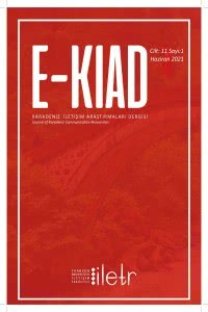FİLM ELEŞTİRİSİNDE BİÇİM-İÇERİK SORUNU
FORM-CONTENT PROBLEM IN FILM CRITICISM
Cinema, criticism, film criticism, content, form, essence (idea), style,
___
- Andrew, J. D. (2010). Büyük Sinema Kuramları.(Çev: Z. Atam). İstanbul: Doruk Yay.
- Büker, S. (1989). Film ve Gerçek. Eskişehir: Anadolu Üniversitesi Yay.
- Cemal, A. (2000). Sanat Üzerine Denemeler. İstanbul:Can Yay.
- Cemal, A. (2002). Bizi Yaşatanlar ve Öldürenler. İstanbul: Can Yay.
- Cevizci, A. (1999). Felsefe Sözlüğü. (3. Basım). İstanbul: Paradigma Yay.
- Bordwell, D. (2000). Modernizm, minimalizm, melankoli: Theo Angelopoulos ve görsel biçim(Çev. A. Ufuk). Yeni İnsan Yeni Sinema, 7, 25-32.
- Buckland, W. (2018). Sinemayı Anlamak. (Çev: T. Göbekçin). İstanbul: Hayal Perest Yay.
- Demopoulos, M. ve Liappas F. (2006). Yunan kırsalı ve tarihi içinde bir yolculuk: Gezgin oyuncular. Dan Fainaru. (Ed.), Theo Angelopoulos içinde (s.18-25). İstanbul: Agora Kitaplığı.
- Erinç, M. S. (1998). Sanatın Boyutları. İstanbul: Çınar Yay.
- Erinç, M. S. (1995). Kültür Sanat- Sanat Kültür.İstanbul:Çınar Yay.
- Fainaru, E. (2006). Sessizlik, Diyalog Kadar Anlamlıdır: Leyleğin Adımı. Dan Fainaru. (Ed.), Theo Angelopoulos içinde (s. 89-98). İstanbul: Agora Kitaplığı.
- Fuat, M. (1992). Çağdaşımız Makyavel. İstanbul:Adam Yay.
- Güney, Y. (2003). İnsan, Militan ve Sanatçı Yılmaz Güney. (5. Basım). İstanbul: Güney Yay.
- Gürsel, N. (1992). Nazım Hikmet ve Geleneksel Türk Yazını. İstanbul: Adam Yay.
- http://hanekefilmleri.blogcu.com/kinoeye-roportaji-2002/2269461 (Erişim tarihi: 07.05.2019)
- Kovacs, B. A. ( 2010). Modernizmi Seyretmek. (Çev: E. Yılmaz). İstanbul: De Ki Yay.
- Kuçuradi, İ. (1997). Sanata Felsefeyle Bakmak.(2. Basım). Ankara: Ayraç Yay.
- Mitchell, T. (2006). Ölü Mekanı ve Ölü zamanı Canlandırmak: Megalexandros. Dan Fainaru. (Ed.), Theo Angelopoulos içinde (s.33-39). İstanbul: Agora Kitaplığı.
- Moran, B. (1994). Edebiyat Kuramları ve Eleştiri. İstanbul: Cem Yay.
- Özel, A. (2014). Estetik ve Temel Kuramları. Ankara: Ütopya Yay.
- Rhode, E.(1984). A History of the Cinema. London: Penguin Books.
- Sartre, J. P. (2008). Aydınlar Üzerine.(3. Basım). İstanbul: Can Yay.
- Sartre, J. P. (1963). Çağımızın Gerçekleri.(Çev: S. Eyuboğlu, V. Günyol). İstanbul:Çan Yay
- Sontag, S. (1991). Sanatçı: Örnek Bir Çilekeş.İstanbul: Metis Yay.
- Sontag, S. (2015). Yoruma Karşı.(Çev: O. Akınhay). İstanbul: Agora Kitaplığı.
- Soupault, P. (1978). Şarlo. İstanbul: Çağdaş Yay.
- Tunalı, İ. (1983). Estetik Beğeni. İstanbul: Say Yay.
- Yıldız, S. (2015). Vsevolod Illarionovch Pudovkin. Sinema KuramlarıI. (Derleyen: Zeynep Özarslan). İstanbul: Su Yay.
- ISSN: 2146-3212
- Başlangıç: 2011
- Yayıncı: Karadeniz Teknik Üniversitesi
ÖLÜ BEDENİN POLİTİKASI: “BİR ZAMANLAR ANADOLU’DA”DA ABJECT KARŞILAŞMALAR1
Mehmet Ozan GÜLADA, Caner ÇAKI
REKLAMDA HİKAYE ANLATIMININ ETKİLER HİYERARŞİSİ BAĞLAMINDA İNCELENMESİ
Sezen ÜNLÜ, Yavuz TUNA, Züleyha ÖZBAŞ ANBARLI, Duygu TOSUNAY
FİLM ELEŞTİRİSİNDE BİÇİM-İÇERİK SORUNU
KURUMSAL İTİBARIN ÖLÇÜLMESİ: GÜMÜŞHANE ÜNİVERSİTESİNİN İÇ PAYDAŞLARI TARAFINDAN ALGILANIŞI
